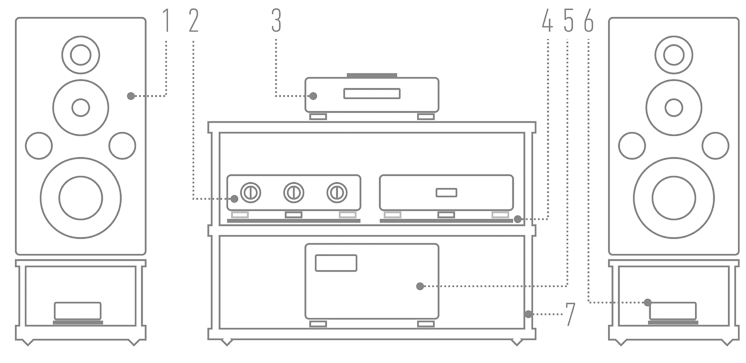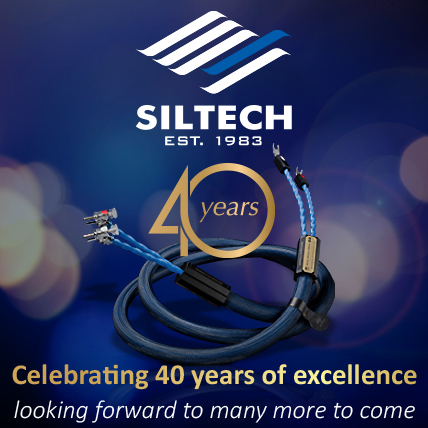|
HEADPHONE AMPLIFIER Gold Note
Manufacturer: AKAMAI S.r.l. |

|
Review
text by WOJCIECH PACUŁA |

|
No 252 May 1, 2025 |
THOUGH IT'S HARD TO BELIEVE, the HP-10 is the first headphone amplifier from this manufacturer, unless I'm forgetting something. And yet, the “headphone revolution,” because that's how you have to consider what's been happening in the audio equipment market for more than a dozen years now, would seem to be a brilliant, self-perpetuating mechanism for any manufacturer of equipment for listening to music not through speakers, but in a personal, intimate way. 
Thus, from loners, largely freaks, people using headphones have grown into the most progressive group of music fans and audiophiles. And I remember that only twenty years ago I became almost a court reviewer of such products in “Audio”, where not only no one had experience with them, but no one took them seriously. Studio - by all means, but home? And even more so the outside? This was not an isolated case, but the state of the entire household appliance segment dealing with audiophile equipment. Therefore, the lack of a dedicated device of this type in Gold Note's lineup must have been a conspicuous absence for its fans, and a significant one at that. Headphone outputs were, of course, present in other products from this company, some of which, by the way, had dedicated headphone amplifiers implemented, to mention, of course, integrated amplifiers, D/A converters or file players. But a separate device of this type did not exist. No wonder, then, that once a product called “headphone amplifier” was introduced, bearing the appropriate symbol - HP = Headphone Amplifier - the manufacturer made sure that it was a special device. Otherwise it wouldn't have had a chance in an incredibly crowded, extremely competitive market, where the cards are dealt by manufacturers from the Far East, with an emphasis on China. In promotional materials sent out late last year, when the HP-10 went on sale, we could read:
▌ HP-10 Deluxe IN ITS BASIC FORM, the HP-10 is a classic headphone amplifier with analog inputs and outputs; the latter are adjustable, so you can connect the unit as a preamplifier. It is a modular design and is available in three versions: the basic HP-10 (8800 PLN), the HP-10 BT (9350 PLN) and the tested HP-10 Deluxe. As the manufacturer says, “all you need to do is connect the sound source and headphones.” The HP-10 BT offers analog inputs and outputs, but adds the ability to stream signal via Bluetooth using aptX HD 5.1 as it integrates an ESS Sabre DAC. As it reads, all you have to do is connect your sources or “stream directly from a smartphone, tablet or computer via Bluetooth.” The Deluxe version adds another option - connecting an external signal source through a USB-C digital input. In this case, the D/A converter is different, it's an AKM AK4493 chip. Regardless of the version, the unit is part of the “10” series, along with an integrated amplifier, CD and file players, a digital-to-analog converter, a phono preamplifier and an all-in-one system. They all share chassis of the same size and a small front panel, measuring just 200 mm wide and 80 mm high. Such unification allows for economies of scale. What Cyrus successfully practiced years ago. 
FEATURES • The HP-10 is one of the devices offering an abundance of features. It's a class-A amplifier operating in balanced mode, regardless of whether you choose XLR or RCA inputs. Its amplification circuit is based entirely on transistors, and you'll find integrated circuits only in the DAC section and in the role of the volume control. It offers as many as four headphone outputs, two of which - a Pentaconn ø 4.4mm and a 4-pin XLR - are balanced; unbalanced are the mini-jack and big jack sockets. As I said, the amplifier in each version offers many interesting and really useful features. All of them can be managed via remote control and touch screen in a dedicated menu called STUDIO. There you will find such adjustable functions as Crossfeed (three modes), Harman Curve EQ (three modes), damping factor, gain (two modes), absolute phase and Superflat. They are all implemented in the analog domain and applied in real time to “fine tune the sound”. The easiest way to change them is through the touch screen. On it you’ll find three separate “profiles”, for three different headphones, which we be set completely independently. The Crossfeed mode allows the L and R channels to be partially or completely combined, offering, Gold Note asserts, “a more realistic 3D image, depending on the type of headphones and music genre.” The adjustable DF (Damping Factor), on the other hand, provides the ability to “perfectly match your favorite headphones.” It also features a circuit with Harman Curve, separately for treble, midrange, bass or full spectrum in real time, in any combination. And it's this feature that I find most interesting. | Harman Curve 
WHEN WE LOOK AT the measurements of speakers and headphones, what catches an eye is the shape of the frequency response curve of the latter. While speakers strive, in general, for as flat a bandwidth as possible, the measurement of headphones is quite different, and the graph resembles several curves connected to each other. This is because the physical shape of our ears amplifies certain frequencies and attenuates others. As we read on the Headphonia website:
For this reason, the manufacturer must average the measurements for many different ear shapes. WHAT is important- the basis for these findings is listening, not measurements. The Harman curve is one such proposal “averaged” and further adjusted for subjective sound perception. Its source was a study conducted by Todd Welti and Sean Olive of Harman International, which culminated in an article entitled The Relationship between Perceptions and Measurement of Headphone Sound Quality. The results of the study were presented in San Francisco at the 2012 Audio Engineering Society convention. The study was aimed at developing methods for controlled listening tests that audio engineers could use to predict accurate and reliable sound measurements of headphones preferred by most listeners and their basic sound attributes, such as bass, midrange and treble:
Harman's reference curve shape continues to evolve. The company generated its first curve in 2013, significantly involving low-frequency devices and featuring a DF response with a shelf below 200 Hz. There are two other curves, one presented in 2015 and the other in 2017, containing modified details but a similar target response. ● » You may want to check out also: A Deep Dive Into Harman Curves – The Long Way Round, → www.HEADPHONESTY.com, accessed: 24.03.2025. TECHNOLOGY • The HP-10 headphone amplifier shares its chassis with “10” and “5” series devices, such as the CD-5 player, so we're talking about a small, sleek device, measuring 200 x 80 x 260 mm and weighing 3 kg. Its housing is made of powder-coated steel, with an aluminum front. On its front panel there is only a touchscreen display, four headphone outputs and a knob that is also a button, and it is the one that bears the inscription saying that this is the Deluxe version. The amplifier is a fully balanced dual-mono design and operates in Class A. As the manufacturer says, it uses “audiophile-grade discrete components.” There are as many as four headphone outputs: balanced XLR and Pentaconn 4.4mm, and unbalanced 6.3mm and 3.5mm. The first three are located on the right side, and the last on the left; an additional computer ribbon runs inside to the latter. The signal is fed to the sockets on the rear panel. There are XLR and RCA inputs, and the same outputs. This is a “bypass” - when you feed a signal to the input, the same signal appears at the output (but only in RCA → RCA and XLR → XLR pairs). So you can plug the amplifier into an existing circuit. Below that is the USB-C input. You can't see the Bluetooth antenna, and that's because it's hidden inside. Next to it, there is also a multi-pin DIN socket for an external PSU-10 Evo power supply and two triggers. To tell the truth, instead of a socket of this type, I would rather have seen a multi-pin XLR or LEMO. The analog sockets are gold-plated and from Neutrik. The headphone jacks are also gold-plated, excluding the 6.3mm output. This, in turn, is right after the output capacitors - they are very nice, large film capacitors - so it has a much shorter signal path. 
The layout inside is modular, that is, each circuit uses a separate board. And indeed the passive components are very nice. In addition to the capacitors mentioned, you can see reed switches switching inputs there. The power supply is tiny - it's a modular, externally purchased switching power supply. The optional PSU-10 Evo turns this into four linear power supplies. I would also add that the amplifier modules are actually dual mono circuits, with separate boards for each channel. The amplifier stands on four rubber half-spheres, quasi-feet, which are worth replacing with the product of any of the reputable companies specializing in vibration reduction. To complete the set we get a multi-functional remote control. It is crowded, but quite sensibly laid out. ▌ SOUND HOW WE LISTENED • The Gold Note HP-10 Deluxe headphone amplifier was tested in a HIGH FIDELITY reference system. It was compared to the Leben CS-600X amplifier, which resides in it in a similar capacity. The amplifier was powered by a Harmonix X-DC350M2R Improved-Version cable and stood on its feet on a Finite Elemente Master Reference Pagode Edition Mk II rack’s carbon top. I conducted a separate test with the PSU-10 Evo external power supply. 
I tested the amplifier in two systems: with a backup system, using the S.M.S.L CD-200 CD player as the source, and the main system, with the Ayon Audio CD-35 HF Edition SACD player and Leben T3 file player. From the Ayon Audio player, the signal was routed in balanced form using Acoustic Revive Absolute cables, from the Leben T3 file player with Siltech Single Crown unbalanced interconnects. In the test, I used three different headphones: Lime Ears Anima → Pentaconn, Sennheiser HD800 → XLR 4-pin, and HiFiMAN HE-1000 v2 and Lime Ears Pneuma → 6.35 mm jack. 
|
» RECORDINGS USED FOR THE TEST ⸜ a selection
⸜ FRANK SINATRA, Come swing with me!, Capitol Records CDP 7 94520 2, CD ⸜ 1961/1991. MY FIRST CONTACT WITH THE HP-10 Amplifier was not a promising one. This is because I started the listening by trying with it my two top-of-the-line IEM headphones - In Ear Monitors. This is a variation of this type of design, with its roots in the stage and concerts. These were the personal listening devices of musicians, used instead of the classic, speaker (audition) set up on stage. 
Headphones of this type, including my Pneuma and Anima from Lime Ears, have high sensitivity and low impedance. The idea is that they can be driven by a low-power amplifier, usually installed in a receiver (micro-port), clipped behind the waistband of pants or dresses. Although over time they began to resemble classic headphones, the acoustic feature has survived all the changes. Plugged into amplifiers with high gain and an impedance that doesn't quite match, IEM headphones play brightly, sharply and clearly show the device's own noise. The second „bump in the way” came when I listened to the classic designs, that is, the dynamic Sennheiser HD 800 and AKG K701, and the orthodynamic HiFiMAN HE1000 v2. This is because the device without activated additional functions sounds correct, clean, smooth, but completely lifeless. And it wasn't until I determined which settings seemed best to me, when the “Crossfeed 4”, Harman M” and ‘Harman L’ icons lit up on the display, as well as ‘Superflat’ - wow! Listened to in this way, FRANK SINATRA from a very good, albeit old and “non-audiophile” edition of the Come swing with me! album, with Larry Walsh's 1991 remaster, already in ˻ 1 ˺ Day by Day, sounded dynamic, swinging, extremely deep. I was particularly impressed by the work of the tuba - here in the right channel - whose deep overblowing, so important for this music, is lost. The HP-10 with the Sennheiser HD 800 not only showed it tonally beautifully, but also very accurately located it on stage. Which, we should add, happens very rarely with headphones. And Sinatra's voice was beautiful in its freedom and tangibility. But the tangibility didn't pretend to be intimacy, but flowed from the high volume and excellent positioning on stage. This is due to the “crosfeed” arrangement, which in the No. 4 version adds to the depth of the low end. I am skeptical of any such “inventions” and avoid them if I can. In this case, it is one of the basic components of the sound, without which it would not be so exciting to play. I am not fond of solutions that mix channels with each other, because they bring more bad than good. I've never been bothered by the sound “in the head” and to this day I don't really understand this type of complaint. Headphone listening is what it is, period. And even though I appreciate ways to get around this problem, either through binaural recordings or through proper surround mixing, the vast majority of the music I listen to and am interested in is available from one or two channels. And with them, “crossfeed” smears phantom images, blows out the stage, crippling tonality and resolution. But not in the HP-10. With the Harman curves for midrange and bass turned on, I got a perfectly stable musical image in mono recordings as well, for example with ˻ 13 ˺ I Love You, the track that begins the bonus material on the aforementioned CD. It also didn't take an ounce of weight and aggression from the Countdown to Extinction album by the group MEGADETH in the excellent Mobile Fidelity version released in 2006; this October, my beloved band will play as a support for Disturbed at Krakow's Tauron Arena! For this one album, I turned on an extra icon, “Harman H” on the HP-10 display, because I needed a little more power and focus. But it was the depth of Dave Mustaine's vocals and the excellent reverbs in ˻ 2 ˺ Symphony of Destruction, and then the psychedelic madness of the THE 13th FLOOR ELEVATORS band on the, appropriately titled, album The Psychedelic Sounds of the 13th Floor Elevators, that impressed me the most. It was played with energy, but also perfectly balanced. | Our albums ⸜ THE 13th FLOOR ELEVATORS Charly Records SNAX616 CD ⸜ 1966/2010 
IF WE WERE TO LOOK FOR some classic group playing psychedelic rock, The 13th Floor Elevators would come up on a very short list. They are considered the first group of their kind and originators of the genre name. They are an American rock band from Austin, Texas, formed by guitarist and vocalist Roky Erickson, Tommy Hall and Stacy Sutherland. In its four years of existence, the group has released four albums and seven singles. In November 1966 Houston-based record label International Artists signed the Elevators to a record deal and released their debut album The Psychedelic Sounds of the 13th Floor Elevators. It quickly gained “iconic” status among the emerging counterculture, helped by an accompanying essay written by Tommy Hall, in which the author advocated chemicals (such as LSD), which he described as “a gateway to a higher, non-Aristotelian state of consciousness.” The album was recorded between January 3 and October 11 1966 at Sumet Sound studios, in Dallas. 
The album The Psychedelic Sounds of the 13th Floor Elevators was originally released in mono, and the stereo version was not released until a year later. The label International Artists changed the track listing without the band's permission when the album was first released, and it wasn't until 2009, along with the original mono version, that a new alternate stereo version appeared as part of the Sign of the 3-Eyed Men set, which retained the band's original track listing, as well as riffs on some tracks. A year later, these two versions, in a very nice edition, were presented by Charly Records. The sound of the Elevators album is truly mesmerizing. In the version I'm talking about it is clean, clear, but it hasn't been “restored” either. Just as important as the timbres here are the long reverberations, almost dreamlike spaces, both in the stereo and mono versions. Both have their own charm and it's hard to decide which is the “right” one. Probably zelots of monophony will say that there is nothing to talk about, but in the case of this type of music stereophony brings something extra to the music. A must have! ● LISTENING TO THE MEGADETH album I also took advantage of the “booster”. The “Gain” button may seem to be simply upping the volume - which it is not. Anyone who has designed audio circuits knows that figuring out where to set the gain, then selecting its level in subsequent sections and finally setting the attenuator in all of this changes the sound. The overall gain level is the same, and the sound is completely different. “Gain” in the HP-10 therefore not only raises the gain of the circuit, but also sharpens the sound by boosting the bass and treble. With The 13th Floor Elevators I didn't need that. Despite the rather bright realization, the Italian amplifier didn't sharpen the sound, it didn't strip it of what I was talking about, that is madness. In the 2010 Charly Records version we get both a mono and stereo version of this material - and it was the latter that turned me on so much. There was incredible space, depth and breath in it. I didn't mind the scattering of sound sources to the extremes of the channels, as everything blended and clicked together nicely. 
Probably due to its deep sound and wide and deep, as well as very well defined soundstage, electronic music albums will also sound great with the HP-10. And both in the modern sense of the word, as well as classic one, such as KRAFTWERK's Autobahn, housed in the 3-D box. Wide, deep and, above all, dynamic and low timbre. With HiFiMAN headphones the sound was even deeper and more saturated. So much so that I switched from the “Crossfeed 4” setting to No. 3. It has a similar effect as far as space is concerned, it too deepens the sound and boosts the bass, but to a slightly lesser degree than No. 4. Depending on my mood, I could also reach, why not, for the “Harman H” button to gently boost the treble. PSU-10 EVO • The experiences I've had with the PSU-10 Evo so far have been positive, even very good. But I also had to adapt each time to the new reality I achieved with it. And that's because after switching from listening without the PSU to listening with the PSU, the sound’s attack slightly loses its immediacy. It is more rounded, and the range from around 500-800 Hz, i.e. the midrange, comes to the fore in terms of tonality. And only returning to listening with the PSU shows that it is a valuable complement to the tested headphone amplifier, and - ultimately - something that simply, sooner or later, is a must have. And that's because the soundstage deepens with it, and the treble sound even more accurate, sonorous, but also nobler. And this is true regardless of the type of music. In this configuration, the sound is really extremely deep, saturated, but also very, very spacious. SMARTPHONE • The presence of Bluetooth and USB-C connectivity is a clear invitation to listen to music from a smartphone, presumably from any of the streaming services; in my case it was Tidal. Bluetooth uses a lossy codec, it's clear, in any version. It's also not entirely transparent to the signal, mainly due to latency and jitter, making sound smearing and treble problems perfectly audible on good equipment The implementation of this receiver in the HP-10 proved to be very good. The presentation was not jittery or muddled, nor was it brightened. Tonal balance was maintained, and dynamics - the weak point of Bluetooth - was really good. Which improved even more when the file transport (the transport section of the Lumin T3) was connected via USB input. Both ways of transferring the signal have a similar sound signature, but with the cable transfer, the pleasant sound also comes with better resolution and thus emotional involvement. This is a really nice addition, allowing you to listen to streaming music in a comfortable way. ▌ Summary GOLD NOTE HP-10 is an excellent example of how, with the tools available to all, to prepare a device whose sum of features will be much greater than the value of the individual components. By itself correct, pleasant, perhaps even interesting, the real magic shows when you turn on the functions it is equipped with. 
This sound is low, dense and incredibly spacious. And it's well-defined space, real space, not imagined space. The sound sources have solid body and depth. Resolution is really good, although you can find even better designs on the market in this respect. The important thing is that everything in the HP-10 is put together in such a way that we get an internally complex sound that draws us in, activates to buy more music, encourages to spend time with it, so that you can reach for the headphones at any time. Bravo! ● ▌ Technical specifications (according to the manufacturer)
Type: Class A, dual-mono 
THIS TEST HAS BEEN DESIGNED ACCORDING TO THE GUIDELINES adopted by the Association of International Audiophile Publications, an international audio press association concerned with ethical and professional standards in our industry, of which HIGH FIDELITY is a founding member. More about the association and its constituent titles → HERE. |

|
Reference system 2025 |
|
 1) Loudspeakers: HARBETH M40.1 |REVIEW| 2) Line preamplifier: AYON AUDIO Spheris III Linestage |REVIEW| 3) Super Audio CD Player: AYON AUDIO CD-35 HF Edition No. 01/50 |REVIEW| 4) Stands (loudspeakers): ACOUSTIC REVIVE (custom) |ABOUT| 5) Power amplifier: SOULUTION 710 6) Loudspeaker filter: SPEC REAL-SOUND PROCESSOR RSP-AZ9EX (prototype) |REVIEW| 7) Hi-Fi rack: Hi-Fi rack: finite elemente MASTER REFERENCE PAGODE EDITION Mk II, more → HERE |
|

|
Cables Analog interconnect SACD Player - Line preamplifier: SILTECH Triple Crown (1 m) |ABOUT|» ANALOG INTERCONNECT Line preamplifier → Power amplifier: Siltech ROYAL SINLGE CROWN RCA; review → HERE Speaker cable: SILTECH Triple Crown (2.5 m) |ABOUT| |

|
AC Power Power cable | Mains Power Distribution Block - SACD Player: SILTECH Triple CrownPower (2 m) |ARTICLE| » POWER CABLE Mains Power Distribution Block → Line preamplifier: Acoustic Revive ABSOLUTE-POWER CORD, review → HERE » POWER CABLE Mains Power Distribution Block → Power amplifier: Acoustic Revive ABSOLUTE-POWER CORD, review → HERE Power cable | Power Receptacle - Mains Power Distribution Block: ACROLINK Mexcel 7N-PC9500 (2 m) |ARTICLE| Power Receptacle: Acoustic Revive RTP-4eu ULTIMATE |REVIEW| » ANTI-VIBRATION PLATFORM under Acoustic Revive RTP-4eu ULTIMATE: Graphite Audio CLASSIC 100 ULTRA, review → HERE Power Supply Conditioner: Acoustic Revive RPC-1 |REVIEW| Power Supply Conditioner: Acoustic Revive RAS-14 Triple-C |REVIEW| Passive filter EMI/RFI: VERICTUM Block |REVIEW| |

|
Anti-vibration Speaker stands: ACOUSTIC REVIVE (custom)Hi-Fi rack: finite elemente MASTER REFERENCE PAGODE EDITION Mk II, more → HERE Anti-vibration platforms: ACOUSTIC REVIVE RAF-48H |ARTICLE| » ANTI-VIBRATIONAL FEET: |

|
Analogue Phono preamplifier: Phono cartridges:
Clamp: PATHE WINGS Titanium PW-Ti 770 | Limited Edition Record mats:
|

|
Headphones » HEADPHONE AMPLIFIER: Leben CS-600X, review → HEREHeadphones: Headphone Cables: Forza AudioWorks NOIR HYBRID HPC |
main page | archive | contact | kts
© 2009 HighFidelity, design by PikselStudio,
projektowanie stron www: Indecity


























